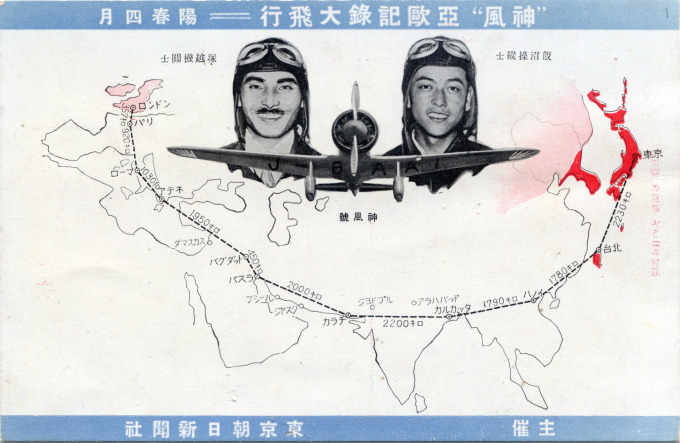
Kamikaze pilot Masaaki Iinuma (right) and navigator Kenji Tsukagoshi (left), World Record Flight Tokyo-London, 1937. The duo flew what was then the world’s fastest production airplane a record 9,542 miles from Tokyo to London in tribute of the coronation of King George VI, in 94 hours (total flight time: 51 hours 17 minutes) at an average speed of 187 mph.
See also:
First Airplane Flight in Japan, 1910
Tokyo-London-Rome Flight, 1931
“For a brief period in 1937, the Mitsubishi Type 97 Ki-15 was the fastest production airplane in the world. It was a high-speed reconnaissance aircraft capable of flying faster and higher than any fighter it would encounter at the time. Fully aerobatic, it could out-maneuver all fighters of the era – if they could catch it at all.
“The second prototype Ki-15 was purchased by the Asashi Shimbun, a large Tokyo newspaper, as a fast press courier plane, and named Kamikaze-go. It flew a record-breaking flight from Tokyo to London for the coronation of King George VI. Its top speed of 300 mph and trouble-free performance impressed the Western world with the abilities of Japanese aviation.
“Although the record flight was meant as a tribute, its flight might have been an embarrassment to the King because the fastest British aircraft in production at the time was an open-cockpit biplane.”
– At The Field: Offbeat Stories About R/C Model Airplanes and the People Who Fly Them, David P. Andersen, 2004
“At 3.30 p.m. on Friday a large welcoming crowd, largely consisting of the Japanese residents in London, who had been waiting since mid-day, saw a characteristically “over-nosed” monoplane coming in from the direction of Paris. Mr. Iinuma, the pilot, made two complete circuits of the aerodrome while two Leopards, bulging with Press photographers, made an abortive attempt to keep up with the machine, both by diving and by cutting off corners. Then he brought it in slowly and carefully to land neatly, with a burst of engine and straight off the glide, in the centre of the available landing area—which was restricted by flagged-off areas populated by various working parties.
“Thus was the ‘goodwill’ flight of Mr. Iinuma and Mr. Tsukagoshi from Tokio to London completed in 94 hours. The effort is of rather unusual interest in that the aircraft and engine were of Japanese manufacture.
“The first section of the flight which was sponsored by the Tokyo Asahi Press commenced from Tokio at 5.12 p.m. on Monday, April 5, and covered 1,400 odd miles to Taihoku, Formosa. In spite of the weather conditions, which were the worst experienced on the whole trip, and average speed of almost 200 m.p.h. was maintained.
“After leaving Hanoi (French Indo-China), the next stop, bad visibility to Vientiane lowered the average a little and it was not until the Baghdad to Athens stage was covered that the average speed for a section exceeded 100 m.p.h.; in this case 1,280 miles was covered in 6 hours 17 mins., a speed of 202 m.p.h. Strong head-winds were encountered while crossing India.
“Last Friday the final European stages were commenced; leaving Athens at 5.40 a.m., Rome was reached at 8.46 a.m.—710 miles at 219 m.p.h. After only 50 minutes the Divine Wind took the air again for Paris, arriving there at 1.33 after having put up an average of 230 m.p.h. for the 730 miles. Finally, at 2.15 on Friday, April 9, Mr. Iinuma took off for Croydon and completed his flight within 75 minutes.”
– Flight, April 15, 1937
“A French newspaper had offered a substantial monetary prize for the first aircraft to fly between Paris and Tokyo within 100 hours. Many aviators had failed in the attempt, including André Japy, the French aviator whose plane crashed into the mountains of Kyūshū on the last leg of his record attempt from Paris to Tokyo.
“The Kamikaze-go, a Mitsubishi Ki-15 Karigane aircraft (registration J-BAAI), sponsored by the newspaper Asahi Shimbun, succeeded where others failed. Flight-time from Tokyo to London took 51 hours, 17 minutes and 23 seconds, piloted by Iinuma Masaaki (1912–1941) with Tsukagoshi Kenji (1900–1943) serving as navigator. The flight was the first Fédération Aéronautique Internationale aviation record to have been won by the Japanese.
“This record flight to Europe made the pilot a national hero, and Iinuma was acclaimed as the ‘Japanese Lindbergh’. Both the pilot and navigator were awarded the Légion d’honneur by the French government.”
– Wikipedia
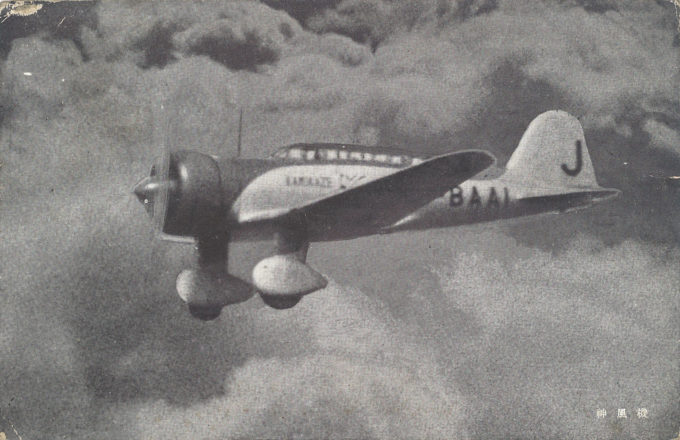
Promotional postcard published by the The 5th All Japan Student Aviation Championships, 1939. Despite being built as the second prototype of the Ki-15 flight reconnaissance class and touring the country after its world record flight, Kamikaze-go would be called to active duty during the Second Sino-Japanese War performing its reconnaissance role until the Ki-15 reached full factory production, at which time Kamikaze-go became a trainer. A flight accident ended its Army career. The aircraft was restored by its original owner, Asahi Shimbun, resuming its role as company flagship, before a second accident rendered Kamikaze-go unairworthy. Kamikaze-go survived the Pacific War as a museum piece but was later burned as war material by Occupation troops.
Aircraft performance
Maximum speed: 480 km/h (298 mph) at 4,000 m (13,125 ft)
Cruise speed: 320 km/h (199 mph) at 5,000 m (16,404 ft)
Range: 2,400 km (1,491 mi)
Service ceiling: 11,400 m (37,400 ft)


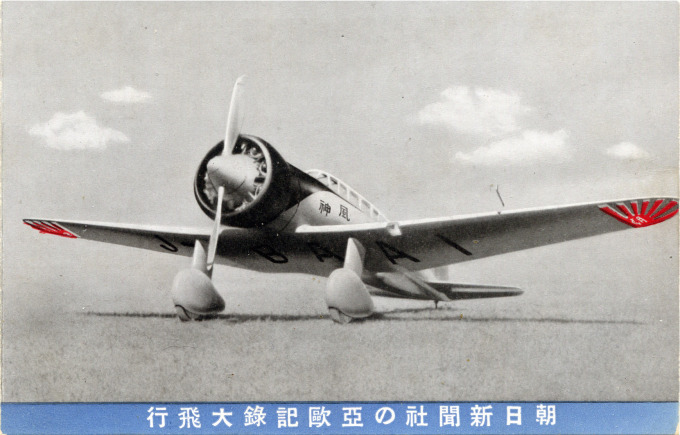
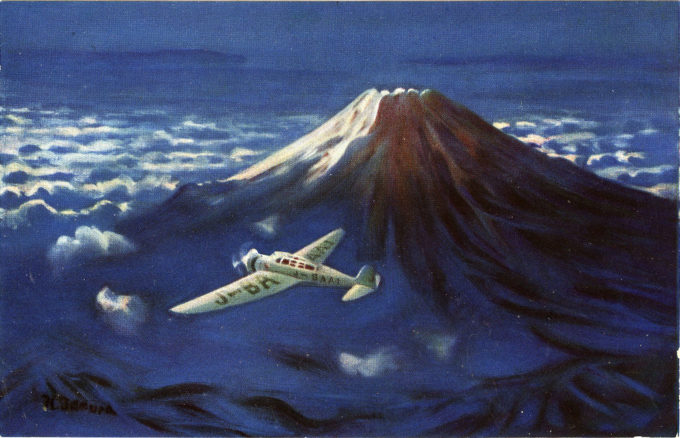
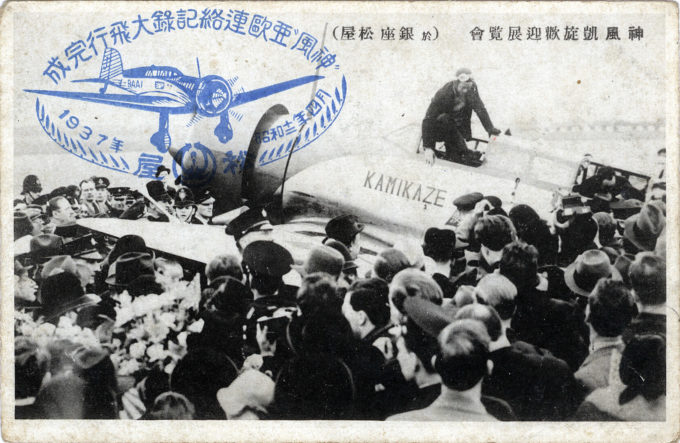
Pingback: Asahi Shimbun (Newspaper) building, c. 1940, at Sukiyabashi.. | Old Tokyo
Pingback: Asahi Shimbun Building, c. 1930. | Old Tokyo
Pingback: El Asahi Shimbun, uno de los periódicos más antiguos y emblemáticos de Japón | Kiotokio - Todo sobre Japón - Sitio web especializado en actualidad, sociedad, videojuegos, manga, anime, cine y literatura japonesas.
Pingback: Gasuden “Kōken-ki” world record flight, c. 1937-38. | Old TokyoOld Tokyo